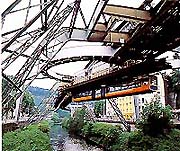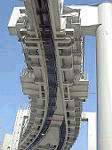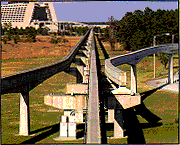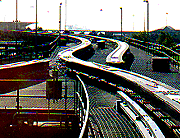Once upon a time ... a quaint suspended monorail was built between the villages of Elberfeld and Barmen in Germany. United by the monorail system and the River Wupper, the villages would one day merge to become the city of Wuppertal. The industrial city would gain recognition and world-wide fame because of their pioneer monorail. But, the monorail had a problem ... the switches. Wuppertal's monorails use double-flanged steel wheels to run on a single elevated rail. The vehicles are suspended below. Due to the "hang-over-the-side" design of the suspended vehicles, switching requires cumbersome rotating switches (picture above). This limits the system to a linear loop in which trains turn around at each end without the use of a switch. Spur lines and bypasses don't exist either. Because of these limitations, an unfair "switch myth" was created that all monorails have switching problems. Even though great strides in both track and switch technologies were made in the 50's, 60's and beyond, the myth today remains a thorn in the side for monorail proponents. Partly at fault are the rail consultants and suppliers that benefit by the continuation of competing so-called conventional rail. Here at The Monorail Society, we continue to be surprised by the amount of "rail experts" that don't have a clue when it comes to the subject. One more reason for the perpetuation of the myth is the continual appearance of it in print. Even today, some modern encyclopedias proclaim that there are problems with monorail switches. Switch Defense Initiative So, at the suggestion of one of our more enthusiastic TMS members, Dr. Robert W. Selle, it is time to fight back with facts and pictures. We begin with a brief look at some of the major switch technologies in use today.
Still Skeptical? Probably the best way to argue that monorail switches work is to let you know where they are and briefly explain the importance of them. What follows is a list of monorail systems operating right now (or very soon) that cannot operate without the benefit of switches. Without efficient on-line operating switches, these systems would be closed! Tokyo-Haneda , Japan (1964). ALWEG straddle-beam technology is used for this eight-mile dual-beam system. Segmented and new high-speed crossover switches operate every few seconds. This system has proven monorail switches reliable in over 30 years of daily operation. Shonan , Japan (1970). A single-line suspended monorail with dual direction service. How is this done? Trains pass each other at stations where the track briefly splits, with switches based on the French SAFEGE technology developed in the 1950's. Walt Disney World (1971 and 1982). Although the WDW system consists of three loops, without switches the system would be unable to operate. Trains access all loops via switches starting right from the twelve-train storage and maintenance facility. Trains transfer from loop to loop depending on traffic demand. The system carries hundreds of thousands of passengers each week. Dortmund, Germany (1984). There are a number of switches on this Siemens-developed suspended monorail. Clever engineering allows for quick switching in these narrow beams. Kitakyushu City, Japan (1985). Another dual-beam ALWEG system with lots of segmented switches. Chiba City, Japan (1988). The world's only dual-beam SAFEGE monorail. It includes a spur line and oodles of switches. Osaka, Japan (1990). On the way to being the longest ALWEG system in the world. The track will eventually loop the city with switches along the entire route. Tampa International Airport (1991). Tampa's Bombardier UM III monorail system is a pinched loop with two switches for direction reversal. One is a seldom-used backup. Newark International Airport (1996). When it opened, the Newark system will became the king of steel rotary switches. Switch platforms exist at the terminal stations as well as along the route. This will give operators flexibility to move trains from beam to beam as required for direction reversal or the occasional need for trains to bypass sections of track under maintenance. Tama, Japan (1998). If monorail switches were a problem, would the Japanese have so many systems operating? Would they keep building new monorails with more switches? Jacksonville, Florida (1998). Bombardier is supplied the city with a UM III peoplemover class monorail system. It is totally automated and also features many online switches. Included in the system are the first passenger-carrying monorail spur lines in the USA. People, how do you get the trains onto those spur lines? Efficient switches like those proven at Bombardier's earlier installation at Tampa Airport, perhaps? Kuala Lumpur, Malaysia (2003). Switches exist at each terminal station for reversal of train direction, another switch near the southern terminal accesses the maintenance/storage facility. Las Vegas, Nevada (2004). With the four-mile system, there are switches at the terminal stations for direction reversal and access to the maintenance/storage facility, as well as two switches along the route to facilitate bypassing and special short runs. Additionally, there is a switch at the Hilton for a future dual-lane spur line to the west side of the Strip. Chongqing Monorail, China (2005). China's first major monorail system, based on Hitachi technology. Plenty of mandatory-use switches. Sentosa Express, Singapore (2007). Hitachi technology, direction reversal switches required for operation. Palm Jumeirah Monorail, Dubai (2009). Reversal direction switches, as with all other Hitachi monorails. Mumbai Monorail, India (2014). Reversal direction switches, as with all other Scomi monorails. Line 15, Sao Paulo, Brazil (2014). Reversal direction switches, Bombardier's first outside North America. Daegu Monorail, South Korea (2015). Reversal direction switches, as with all other Hitachi monorails. That's just up through 2015! All new monorails built since then also feature fast switches that are absolutely necessary. In Conclusion Naysayers, please give it up! Monorail switches work just fine and are doing so as you read this. In fact, when is the last time you heard of a monorail switch accident? In comparison, conventional rail switches are quite capable of causing accidents. Often, switch accidents have result in system shutdowns or delays, even injuries. This isn't uncommon with conventional rail. Monorail switches on the other hand have a clean record. May the Switch Myth Rest in Peace! |




